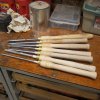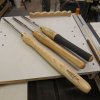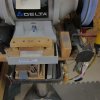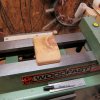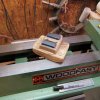odie
TOTW Team
- Joined
- Dec 22, 2006
- Messages
- 7,113
- Likes
- 9,741
I have been using the Henry Taylor "Artisian" M2 bowl gouges for the past few years, and have been very happy with the quality of this gouge. It's not polished to a high degree.....but, I polish them myself on a 3M deburring wheel.
The 17" Taylor handles are not to my liking at all, and I've been cutting them down to 14" or less. (1st pic) The longer 17" handles are just too clumsy, and that added few inches may be a selling point, but useless and in the way, for practical use.
The Henry Taylor M2 bowl gouges are a great tool, and are as high quality and cheaper than the Robert Sorby. (Which, if it weren't for the price, I'd have more Sorbys...... .....the Sorby is a very good tool, but I just can't justify paying more and not getting more.)
.....the Sorby is a very good tool, but I just can't justify paying more and not getting more.)
Recently, I've become aware of the Hamlet M2 bowl gouges......so, bought a couple of them to try out. These Hamlet M2 bowl gouges have as good M2 steel as both the Henry Taylor, or the Robert Sorby. The Hamlets are about $10 cheaper than the Taylors, and the Taylor Artisian is about $10 cheaper than the Sorbys. I buy two at a time, and take advantage of the 10% discount.
The Hamlet gouges come with a 14" handle, so I don't bother to cut them down. I'd prefer the handles to be slightly thinner, but are very usable as they come. I suppose that's one advantage to having the need to cut them down......I can shape them to any shape of my choice. This is not necessary, though. The Hamlet M2 gouges also need polishing.......no problem with the 3M deburr wheel.....it's quick and easy.
One advantage to the new Hamlet M2 bowl gouges, is they have a 7" flute.....instead of the usual 6" or less. This adds quite a bit of additional life span to the tool.........and is golden, in my opinion!
The need for polishing is not a consideration.......but the reduced price, shorter handle, and longer flute, make the Hamlet M2 bowl gouges a much more appealing option for me.......and, unless something better comes along, I'll continue to buy more of these.......
ooc
First pic shows shortened Henry taylor tools, with one original as an example.
Second pic shows one Hamlet bowl gouge currently in use. This has black cloth hocky tape wrapped on the grip area. With it, is one original Henry Taylor Artisian, and one original Hamlet gouge. Notice the added length of the Taylor tool handle, and the shorter flute.
.
The 17" Taylor handles are not to my liking at all, and I've been cutting them down to 14" or less. (1st pic) The longer 17" handles are just too clumsy, and that added few inches may be a selling point, but useless and in the way, for practical use.
The Henry Taylor M2 bowl gouges are a great tool, and are as high quality and cheaper than the Robert Sorby. (Which, if it weren't for the price, I'd have more Sorbys......
Recently, I've become aware of the Hamlet M2 bowl gouges......so, bought a couple of them to try out. These Hamlet M2 bowl gouges have as good M2 steel as both the Henry Taylor, or the Robert Sorby. The Hamlets are about $10 cheaper than the Taylors, and the Taylor Artisian is about $10 cheaper than the Sorbys. I buy two at a time, and take advantage of the 10% discount.
The Hamlet gouges come with a 14" handle, so I don't bother to cut them down. I'd prefer the handles to be slightly thinner, but are very usable as they come. I suppose that's one advantage to having the need to cut them down......I can shape them to any shape of my choice. This is not necessary, though. The Hamlet M2 gouges also need polishing.......no problem with the 3M deburr wheel.....it's quick and easy.
One advantage to the new Hamlet M2 bowl gouges, is they have a 7" flute.....instead of the usual 6" or less. This adds quite a bit of additional life span to the tool.........and is golden, in my opinion!
The need for polishing is not a consideration.......but the reduced price, shorter handle, and longer flute, make the Hamlet M2 bowl gouges a much more appealing option for me.......and, unless something better comes along, I'll continue to buy more of these.......
ooc
First pic shows shortened Henry taylor tools, with one original as an example.
Second pic shows one Hamlet bowl gouge currently in use. This has black cloth hocky tape wrapped on the grip area. With it, is one original Henry Taylor Artisian, and one original Hamlet gouge. Notice the added length of the Taylor tool handle, and the shorter flute.
.
Attachments
Last edited:

